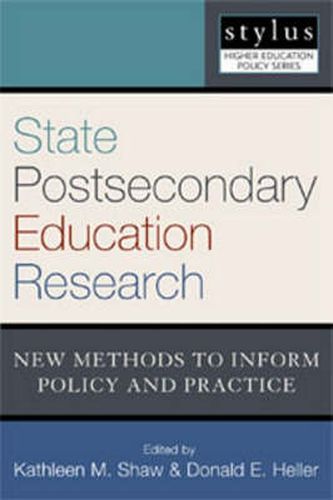Readings Newsletter
Become a Readings Member to make your shopping experience even easier.
Sign in or sign up for free!
You’re not far away from qualifying for FREE standard shipping within Australia
You’ve qualified for FREE standard shipping within Australia
The cart is loading…






This is an opportune time for researchers in higher education to examine policy via cross-state comparative analyses. Momentous court, legislative and policy developments that impact state-level higher education policy are emerging at a rapid rate. The states have emerged as postsecondary policy innovators in the areas of student financing, institutional accountability, and student access. Following political scientists’
rediscovery
of states as units of analysis - because they constitute unique
natural laboratories
for testing theory and hypotheses about political behavior and policy adoption dynamics - this book introduces this perspective as an increasingly important tool for researchers in higher education. This book provides an in-depth examination of the challenges and opportunities inherent in conducting cross-state higher education policy research. The authors of each chapter use their individual research projects to demonstrate the array of methodological, theoretical, analytical, and political challenges inherent in conducting comparative state-level policy research. Among the innovative methods described is the use of pooled cross-sectional time-series analytic techniques and event history analysis - now widespread within the disciplines of economics and political science - to shift the unit of analysis from the state to the state-year, thus expanding greatly both the statistical power of the models being tested and the data-demands of those models. The goal is to introduce comparative state-level postsecondary policy research to a broader audience, and to contribute to discussions of both the challenges and the importance of this approach to higher education policy research. The book is intended as a resource for researchers in higher education policy and as a text for higher education policy courses. It may also appeal to scholars of educational policy as well as higher education policymakers.
$9.00 standard shipping within Australia
FREE standard shipping within Australia for orders over $100.00
Express & International shipping calculated at checkout
This is an opportune time for researchers in higher education to examine policy via cross-state comparative analyses. Momentous court, legislative and policy developments that impact state-level higher education policy are emerging at a rapid rate. The states have emerged as postsecondary policy innovators in the areas of student financing, institutional accountability, and student access. Following political scientists’
rediscovery
of states as units of analysis - because they constitute unique
natural laboratories
for testing theory and hypotheses about political behavior and policy adoption dynamics - this book introduces this perspective as an increasingly important tool for researchers in higher education. This book provides an in-depth examination of the challenges and opportunities inherent in conducting cross-state higher education policy research. The authors of each chapter use their individual research projects to demonstrate the array of methodological, theoretical, analytical, and political challenges inherent in conducting comparative state-level policy research. Among the innovative methods described is the use of pooled cross-sectional time-series analytic techniques and event history analysis - now widespread within the disciplines of economics and political science - to shift the unit of analysis from the state to the state-year, thus expanding greatly both the statistical power of the models being tested and the data-demands of those models. The goal is to introduce comparative state-level postsecondary policy research to a broader audience, and to contribute to discussions of both the challenges and the importance of this approach to higher education policy research. The book is intended as a resource for researchers in higher education policy and as a text for higher education policy courses. It may also appeal to scholars of educational policy as well as higher education policymakers.